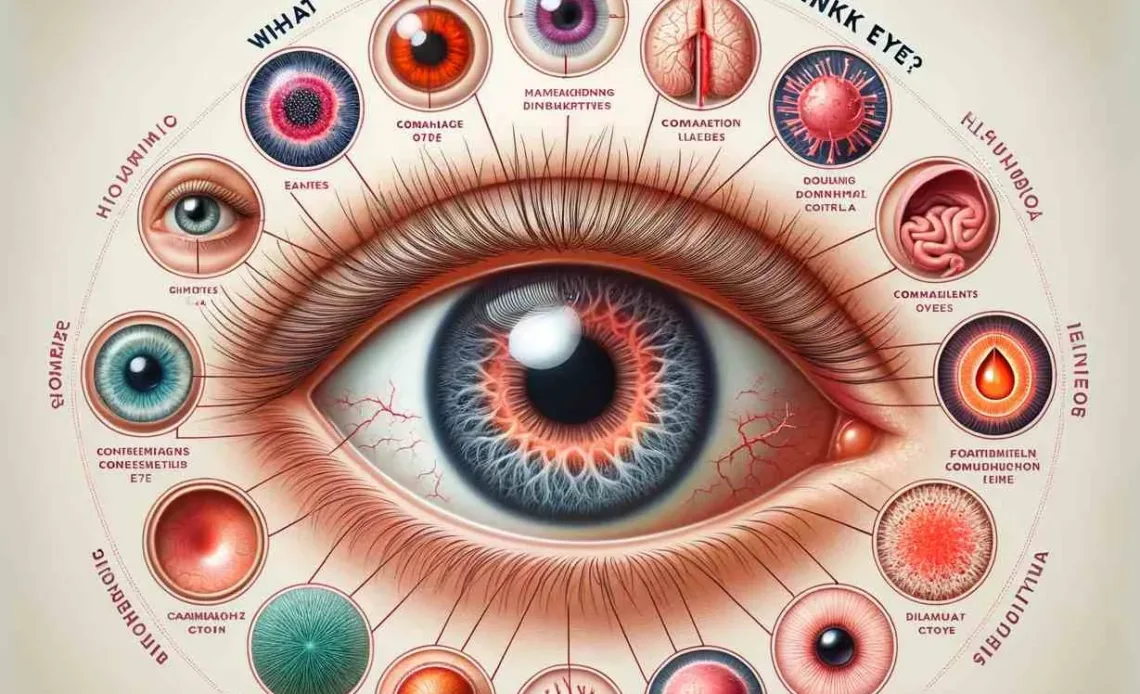Introduction
Pink eye, known medically as conjunctivitis, is a prevalent eye condition. We’ve likely all experienced it at some point – the irritation, redness, and goopy discharge that comes with this infection of the conjunctiva. However, while the pink eye is prevalent, it is also commonly confused with other conditions that cause similar eye symptoms. I learned this firsthand when I struggled with an eye issue and was incorrectly diagnosed with viral pink eye when, in fact, I had blepharitis.
In this essay, I want to provide an in-depth look at pink eye – its causes, symptoms, and treatment – as well as examine several other conditions that are often misdiagnosed as pink eye. I aim to help readers understand the differences between pink eye and other eye problems so they can get the correct diagnosis and treatment if they develop concerning eye symptoms. I will rely on research and experience to offer clear explanations and actionable advice. Let’s start by looking at pink eye before exploring its common impersonators.
| Pink Eye Symptom | True or False? |
|---|---|
| Redness | True |
| Watery Discharge | True |
| Highly Contagious | True |
| Caused by Allergies | False |
What is Pink Eye?
Pink eye is an irritation and inflammation of the conjunctiva – the thin, transparent tissue that covers the white part of the eye and lines the inside of the eyelids. The whites of the eyes become pink or red as a result of it. One or both eyes may be affected by pink eyes.
The hallmark symptoms of pink eye include:
- Redness in the white of the eye
- Swelling and irritation of the conjunctiva
- Increased tear production, leading to watery eyes
- Thick yellow, green, or white discharge accumulating in the corners of the eyes, especially after sleep
- Crusting of the eyelids or lashes
- Itching or burning sensation in the eyes
- Having a foreign body sensation, such as something being in your eye
- Increased sensitivity to light (photophobia)
The pink eye develops quickly, causing one or both eyes to become irritated, red, and weepy within 24-48 hours. Discomfort and discharge are usually worse in the mornings.
There are three leading causes of infectious pink eye:
Viral conjunctivitis – Caused by the same viruses associated with the common cold, flu, or sore throats. Highly contagious.
Bacterial conjunctivitis – Caused by bacteria, often staphylococcus or streptococcus. It’s also very contagious.
Allergic conjunctivitis – Caused by a reaction to allergens like pollen or animal dander. Not contagious.
While annoying, the pink eye often resolves independently within 1-2 weeks without treatment. Viral pink eye cannot be treated with medication, while bacterial pink eye requires prescription antibiotic eye drops to speed healing. Allergic pink eye is treated by limiting exposure to the irritating allergen.
Conditions Commonly Misdiagnosed as Pink Eye
While pink eye is one possibility for red, irritated eyes, many other eye conditions can mimic the symptoms of conjunctivitis. Some of the most common pink-eye impersonators include:
Blepharitis
One of the most frequent conditions mistaken for pink eye is blepharitis. Blepharitis causes inflammation of the eyelids and base of the eyelashes. I learned this firsthand when I scratched my eye, developed redness and irritation, and was misdiagnosed with viral pink eye. After two weeks of worsening symptoms, I saw an ophthalmologist who identified blepharitis as the real culprit.
| Symptom | Blepharitis | Pink Eye |
|---|---|---|
| Redness | Yes | Yes |
| Swelling | Yes | Mild |
| Crusty Eyelashes | Yes | No |
| Contagious | No | Yes |
With blepharitis, the eyes become irritated, red, and swollen, just like with pink eye. However, the emphasis is on eyelid inflammation rather than the conjunctiva. Symptoms include:
- Red, swollen eyelids
- Crusting at the base of the eyelashes
- Greasy flakes or scales on the eyelids
- Blurry vision upon waking
- Increased tear production
- Itching, burning, or foreign body sensation
Blepharitis also tends to cause more significant eye discomfort, which persists even after treating any secondary infection with antibiotic drops.
Treatment focuses on keeping the eyelids and eyelashes meticulously clean using warm compresses, lid scrubs, and tea tree oil. Antibiotic ointment may be prescribed for associated bacterial infection. Blepharitis is chronic, so daily lid hygiene is critical.
Dry Eye Syndrome

Dry eye syndrome is another common masquerader. With dry eyes, there is insufficient tear production to keep the eyes adequately lubricated. This causes chronic irritation that mimics pink eye. Symptoms include:
- Sandy, gritty feeling in the eyes
- Stinging, burning, or scratchiness
- Episodes of more intense dryness and redness
- Stringy mucus in or around the eyes
- Increased irritation in dry environments or during activities like driving
- Watery eyes as the eyes overproduce tears to compensate
Treatment aims to supplement tears using over-the-counter artificial drops, gels, or ointments. Other options include prescription anti-inflammatory drops, punctual plugs to prevent tear drainage, and treatments to increase natural tear production.
Allergic Conjunctivitis
Allergic conjunctivitis results from a reaction to airborne allergens like pollen or dander. This causes inflammation and irritation of the conjunctiva, just like infectious pink eye. Distinguishing characteristics of allergic conjunctivitis include:
- Itching is more pronounced than with an infectious pink eye
- Both eyes are usually affected
- Symptoms correspond with exposure to triggers like pollen season
- Watery discharge is common
- Redness may be less intense than viral or bacterial pink eye
Treatment revolves around limiting exposure to the offending allergen. Oral antihistamines and allergy drops can provide relief. Signs of secondary infection may require antibiotic drops.
Viral Conjunctivitis
Viral conjunctivitis is essentially the same thing as viral pink eye – but suffers from the same problem of being confused with other conditions. The redness and eye discharge of viral pink eye can look identical to bacterial pink eye or allergic reactions. Key distinguishing factors of viral pink eye include:
- The discharge tends to be watery rather than thick and purulent
- Crusting on the lashes and eyelids is less prominent
- Both eyes are usually involved
- Symptoms correspond with having a cold
- Extreme itching is uncommon
There is no specific treatment for the viral pink eye – just managing discomfort until it resolves. Antibiotic eye drops are ineffective.
How to Tell the Difference
Hopefully, by comparing Pink Eye with its common impersonators, some key differences are apparent. Here are a few tips to distinguish pink eye from other possibilities:
Comparing Discharge and Redness
- Thick, sticky, yellow, or green discharge points to bacterial pink eye
- Allergic conjunctivitis produces a clear, watery discharge
- Viral pink eye can cause a watery or mucoid discharge.
- Dry eye and blepharitis don’t usually cause severe discharge
- The pink eye tends to cause diffuse pinkish-redness across the entire eye
- Blepharitis causes intense redness of the eyelids and lashes
- Allergic conjunctivitis leads to localized redness and swelling.
Checking for Contagiousness
- Bacterial pink eye is highly contagious between eyes and people.
- Viral pink eye is somewhat contagious.
- Allergic and dry eye conditions are not contagious.
- Blepharitis is not contagious.
Considering Onset and Duration
- The pink eye comes on rapidly over 24-48 hours
- Dry eye and blepharitis develop more slowly.
- Allergic conjunctivitis corresponds with allergen exposure.
- Pink eye typically resolves within 1-2 weeks.
- Chronic conditions like dry eye and blepharitis persist longer-term.
Eye Discomfort and Vision
- Pink eye causes minor foreign body sensations and irritation.
- Blepharitis causes more intense irritation, primarily upon waking.
- Dry eye leads to scratchy, sandy, uncomfortable eyes.
- Pink eye doesn’t usually impair vision
- Blepharitis can cause temporarily blurry vision after waking
When to See a Doctor

If you notice any sudden, unexplained redness, irritation, discharge, or other concerning eye symptoms, it’s a good idea to see an eye doctor, especially if:
Symptoms Persist or Worsen
Pink eye and other minor conditions should gradually improve within a week or two. Seek medical advice if your symptoms last longer than two weeks or seem to worsen despite home treatment.
To Get a Proper Diagnosis
It can be challenging to distinguish pink eye from its impersonators based on symptoms alone. An exam by an ophthalmologist helps pinpoint the specific cause so that proper treatment can be initiated.
To Prevent Complications
While pink eye is usually a benign, self-limiting infection, complications like corneal scarring are possible if left untreated. Proper diagnosis and treatment help prevent rare complications.
Some warning signs warrant prompt medical attention, including intense eye pain, severely impaired vision, or abnormal pupil reactions. Let an eye doctor determine if urgent intervention is required.
Conclusion:
To wrap up, here are the key points I want readers to take away:
- Pink eye is often confused with other common eye conditions like blepharitis, dry eye, allergies, and viral infections.
- Pay close attention to the character and duration of symptoms to help distinguish pink eye from impersonators.
- When in doubt, see an eye doctor for an accurate diagnosis, especially if symptoms persist or worsen.
- Proper treatment depends on getting the right diagnosis, so make an appointment if you have concerns about sudden eye redness or irritation.
This overview has prepared you to identify pink eye mimics. Please don’t hesitate to see a doctor if you experience sudden, unexplained red-eye symptoms that don’t quickly resolve. Catching and properly treating issues like blepharitis early on can help prevent recurring problems. Read More: Health Blog
FAQs
- What is the most common condition mistaken for pink eye?
The most common condition mistaken for pink eye is viral conjunctivitis. The symptoms of viral pink eye are very similar to bacterial pink eye, including redness, irritation, and discharge. However, viral pink eye will usually resolve independently within 7-10 days without antibiotic treatment.
- How can I know if I have bacterial or viral pink eye?
Some critical differences between viral and bacterial conjunctivitis:
- Viral discharge is often watery, while bacterial discharge is thicker and pus-like
- Bacterial pink eye affects one eye at first, while viral pink eye usually appears in both eyes
- Bacterial pink eye has more crusting/matting of the lashes and eyelids
- Bacterial is highly contagious, while viral is less so
- Bacterial pink eye symptoms are more severe
Seeing an optometrist can help diagnose viral vs. bacterial pink eye through an exam.
- What if my pink eye symptoms don’t improve with antibiotic drops?
If pink eye symptoms don’t improve within a few days of starting antibiotic drops, it may be due to another condition:
- Allergic conjunctivitis – caused by pollen or other allergens
- Blepharitis – eyelid inflammation
- Dry eye syndrome
- Herpes viral infection
See an optometrist for an accurate diagnosis and proper treatment if the pink eye doesn’t resolve with antibiotics.
- How can I find relief if I have a misdiagnosed case of pink eye?
If you’ve been misdiagnosed with pink eye, find relief by:
- Seeing an optometrist for an exam to determine the cause
- Using cool compresses and artificial tears to soothe eyes
- Taking oral antihistamines if allergies are the culprit
- Practicing eyelid hygiene if blepharitis is diagnosed
- Trying antiviral eye drops for suspected viral infection
- Using lubricating drops/gels for dry eye relief
- How can I prevent being misdiagnosed with pink eye again?
To prevent misdiagnosis going forward:
- Learn the critical differences between pink eye and conditions like allergies, viral infection, and blepharitis
- See an optometrist at the first signs of eye redness for accurate diagnosis
- Note which symptoms improve or worsen with initial treatment.
